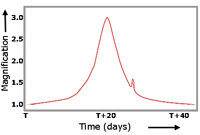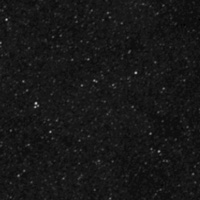Rosetta's gravitational microlensing programme
9 October 2008
In the four weeks since the Rosetta spacecraft flew by asteroid Steins the OSIRIS Narrow Angle Camera has periodically observed the Galactic Bulge in a programme to detect gravitational microlensing events. When combined with simultaneous observations taken with ground-based telescopes this OSIRIS observing programme will provide a unique measure of the mass distribution of disk brown dwarfs.Determining the mass distribution of Galactic bodies
 |
|
Schematic diagram of a microlensing light curve. (Credit: ESA) |
The phenomenon of gravitational lensing can be used to measure the mass of celestial bodies, from stars to planets, irrespective of the light they emit. A massive object, or lens, passing in front of a background source object can result in multiple distorted, magnified and brightened images of the source. Microlensing refers to the cases where the lens mass is such that the multiple images cannot be individually resolved and the light from the images is blended. Since the brightness of the combined image is a function of the projected separation of the lens and source as viewed by the observer, it will vary as the three elements move relative to one another resulting in a characteristic light curve.
The main practical difficulty in detecting microlensing events is the need to monitor millions of stars over a long period of time in order to detect a significant number of isolated events. A number of surveys, such as OGLE, MOA, and SuperMACHO, have been established to observe promising regions of the sky at regular intervals (every few days) for several years.
One of the most suitable regions to observe is the Galactic Bulge - due to the large number of background stars that are potential targets for microlensing. Stars in the Bulge may be lensed by Galactic halo objects and by low-mass disk stars. The latter is of particular interest for assessing the frequency of disk brown dwarfs - other techniques are sensitive only to young brown dwarfs and, as a result, the mass distribution of disk brown dwarfs is not well defined. Microlensing is also of interest since this technique is sensitive even to Earth-mass exoplanets.
Increased baseline results in more sensitive probe
Parallax effects enhance microlensing as a probe of the stellar mass function. If a microlensing event is observed by two observers who are separated by a large baseline, the resulting light curves peak at different times and with different magnitudes. Analysis of the differences of these light curves yields the velocity and distance of the source and the lens star, and can lead to a measure of the mass of the lens star. If the lens is a binary system (two stars, or a star and companion planet) then the masses of the two bodies can be extracted, in the case of a planet to an accuracy of 10%.
To date only one microlensing event (OGLE-2005-SMC-001) has been seen from two different vantage points - from Earth & the Spitzer Space Telescope with a projected separation of 0.2 AU (see Dong et al., 2007). Rosetta will have a projected separation of about 2.5 AU from Earth (during this observing programme) - this is optimal for the detection of lensing events towards the Galactic bulge.
OSIRIS observation programme
 |
|
Extract from a mosaic of OSIRIS NAC images of the Galactic Bulge region. (Click on the image to access the complete mosaic.) Credit: ESA ©2008 MPS for OSIRIS Team |
Previous observations with OSIRIS (of asteroid Steins from a distance of more than 1 AU, in March 2006) have shown that the camera can achieve a signal-to-noise ratio of greater than 50 for objects with an apparent brightness of magnitude 16.6. This means that OSIRIS is sensitive enough to detect most events spotted by ground-based microlensing programmes which are observing the Galactic Bulge. Starting on 7 September and continuing until 4 October a series of 7 observations of the Galactic Bulge have been made with the OSIRIS Narrow Angle Camera. These observations are expected to include about 50 microlensing events at any one time, of which a few can be expected to involve a lens which is a binary. A comparison of events seen by both OSIRIS and one of the ground-based experiments should provide accurate masses for dozens of stars, including disk brown dwarfs and, possibly, one or two exoplanets.
This particular observing programme (see Küppers et al., 2007) is one of a small number of serendipitous science research programmes carried out during Rosetta's cruise phase.
Related Publications
Küppers, M., et al., 2007, "Observations of gravitational microlensing events with OSIRIS – A Proposal for a Cruise Science Observation"
Dong, S., et al., 2007, "First Space-Based Microlens Parallax Measurement: Spitzer Observations of OGLE-2005-SMC-001", The Astrophysical Journal, 664: 862–878, DOI: 10.1086/518536
For more information about this programme please contact:
Michael Küppers, Rosetta Science Operations Centre, ESAC, SpainEmail: Michael.Kueppers
 sciops.esa.int
sciops.esa.intH. Uwe Keller, Max-Planck-Institut für Sonnensystemforschung, Katlenburg-Lindau, Germany
E-mail: keller mps.mpg.de
mps.mpg.de

